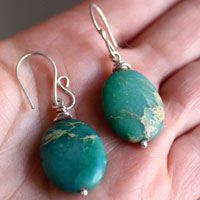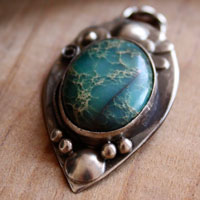- Jewelry
- Inspiration
- Good Deals
- Paintings
- About
- Contact
JEWELRY
- Anklet
- Bracelets
- Brooches
- Cufflinks
- Earrings
- Pendants & Necklaces
- Rings
- Draw your jewelry
- GOOD DEALS
- How to clean your jewel
- Metal we used
INSPIRATION
Serpentine: history, healing properties and lithotherapy

Serpentine properties

The serpentine is a group of silicate minerals comprising more than 20 different species, mostly magnesium-rich phyllosilicates. The precise identification of each variety is complex due to the diversity of their chemical compositions and visual appearances, often leading to confusion with other stones such as jade or nephrite.
The serpentine stands out for its wide range of colors, from white to black, with shades of yellow, green, blue, brown, and gray. Olive-green tones are the most common and sought after, giving the stone its characteristic appearance. The surface of the serpentine is often marbled or veined, with a scaly, waxy, or fibrous texture depending on the variety. It is generally opaque to translucent, with a luster that can be greasy, silky, or vitreous.
The name "serpentine" comes from the Latin serpentinus, meaning "serpent stone," due to its appearance reminiscent of snake skin, particularly with its veined patterns and green hues. This stone is primarily composed of hydrated magnesium silicate, with variable inclusions of iron, aluminum, nickel, chromium, cobalt, zinc, and calcium, giving certain varieties distinctive shades and properties.
The three main varieties of serpentine are:
- Antigorite: Generally massive and compact, with a granular structure. It is one of the most sought-after varieties in jewelry and is sometimes mistaken for jade due to its translucent green color.
- Lizardite: Often softer and with a waxy luster, it displays varied shades ranging from green to yellow and brown.
- Chrysotile: A fibrous variety that constitutes the primary form of asbestos. Its microscopic fiber structure makes it toxic when inhaled as dust. However, raw chrysotile is not used in jewelry to avoid any health risks.
In jewelry, the serpentine is appreciated for its attractive appearance and ease of carving. However, some lower-quality varieties are artificially dyed to intensify their colors. As a result, misleading commercial names such as Suzhou jade, Styrian jade, Teton jade, or new jade are used, when in reality, they refer to treated serpentine.
From a geological perspective, the serpentine plays a key role in the formation of ultramafic zones, where soils rich in nickel, chromium, and cobalt limit plant growth. These regions are often called "serpentine barren zones," but some plant species have adapted to thrive there, giving rise to unique ecosystems.
Finally, the most prized varieties, mainly derived from antigorite, are sometimes referred to as "noble serpentine" or "precious serpentine" due to their translucency and jade-like appearance.
Mines: France, the USA, New Caledonia, Canada, Afghanistan, United Kingdom, Greece, China, Russia, Korea, Austria, India, Burma, New Zealand, Norway, Italy.
History, legends and beliefs about serpentine

Serpentine has been mined and revered since antiquity by many civilizations, including the Sumerians, Assyrians, Persians, and Egyptians, who used it for the creation of seals and cylinder seals. Thanks to its greasy and oily surface when polished, it prevented clay or wax from sticking to the seal, making it easier to use in administration and trade. From the emergence of the Mesopotamian cylinder seal around 3500 BCE, serpentine became one of the preferred materials for these objects, alongside steatite and lapis lazuli.
In the Roman Empire, serpentine was widely used as a decorative and ornamental stone. Known as lapis atracius, it was employed in the making of columns, wall claddings, statues, and mosaics. A specific variety, ophicalcite, gave rise to famous marbles such as Verde di Genova and Vert Maurin, which were highly prized for embellishing villas, temples, and baths.
During the Middle Ages, European sorcerers and alchemists attributed protective powers to serpentine, believing it could guard against snake bites and poisons. Some accounts even claimed that the stone could extract venom from a wound, reinforcing its association with its very name. This belief spread across various cultures, where serpentine was sometimes ground into powder and mixed into medicinal potions thought to purify the blood and protect against diseases.
In India, the city of Bhera was famous for centuries for its deposits of exceptionally pure serpentine. Indian artisans carved the stone into sculptures, decorative objects, weapon handles, and precious cups. Locally, it was called Sang-i-Yashm, while the British referred to it as "false jade" due to its resemblance to the prized gemstone in Asia.
Among the Māori of New Zealand, a local variety of serpentine was known as Tangiwai, meaning "tears" in Māori. According to legend, the stone was considered the petrified tears of a grieving woman, giving it great spiritual significance. It was used to carve sacred pendants, ceremonial ornaments, and ritual objects, often passed down as family heirlooms or used in rites of passage.
Since 1965, serpentine has been designated as the official state rock of California, USA, due to its abundance and the richness of its hues. However, this distinction has been controversial, particularly since 2010, due to the presence of chrysotile in some varieties of serpentine. As chrysotile is the primary form of asbestos, concerns over potential health risks associated with its extraction and handling have led to debates about whether serpentine should retain its official status.
Additionally, serpentine remains a sought-after stone in architecture and sculpture. It is still used for the cladding of prestigious buildings, particularly in Italy and France, where it adorns churches, palaces, and historical monuments.
Healing properties and benefits of serpentine
Serpentine is a stone recognized for its healing, protective, and balancing properties. It acts on both the body and mind, promoting physical regeneration and emotional well-being.
- Serpentine is reputed for its beneficial effects on calcium and magnesium metabolism, contributing to the regulation of blood sugar levels. It is sometimes recommended to help manage hypoglycemia and diabetes.
- It is known for its purifying effect, aiding in the fight against parasitic and bacterial infections while supporting the immune system.
- This stone is associated with strengthening the heart and lungs, promoting better blood circulation and tissue oxygenation. As such, it may be helpful for respiratory issues, asthma, or unstable blood pressure.
- It relieves muscle cramps, menstrual pain, and is believed to ease tension in the lower abdomen and digestive system.
- Serpentine is also linked to hormonal regulation, and some traditions attribute to it the ability to balance milk production in breastfeeding women.
- Thanks to its regenerative properties, it is thought to promote healing and repair damaged cells, helping the skin and tissues recover more effectively after an injury or medical procedure.
- Serpentine is a grounding and harmonizing stone, helping to overcome stress, anxiety, and negative thoughts. It fosters inner serenity and soothes turbulent emotions.
- It is particularly recommended for those seeking to move beyond emotional blockages related to the past, encouraging perspective and the release of repetitive patterns.
- It helps stimulate concentration and mental clarity, facilitating decision-making and emotional management during moments of doubt or confusion.
- In lithotherapy, serpentine is often associated with the activation of the heart chakra (Anahata), enhancing compassion, openness to others, and unconditional love.
- Some traditions consider this stone to facilitate spiritual work and the awakening of inner energies, particularly by strengthening the connection to ancestral wisdom and the Earth's energies.
- It is used to protect against negative influences and toxic energies, creating a vibrational shield around the wearer.
- Finally, serpentineis believed to strengthen the bond with natural forces and nature spirits, making it a valuable ally in meditation and shamanic practices.
 Please note that all healing properties presented for gemstones are gathered from various sources. This information is provided as a service and is not intended to treat medical conditions. It is recommended to consult a healthcare professional for serious medical issues and not to rely solely on gemstones as a treatment.
Please note that all healing properties presented for gemstones are gathered from various sources. This information is provided as a service and is not intended to treat medical conditions. It is recommended to consult a healthcare professional for serious medical issues and not to rely solely on gemstones as a treatment.
Serpentine jewelry samples
To learn more about litotherapy, we recommend you the following books:






